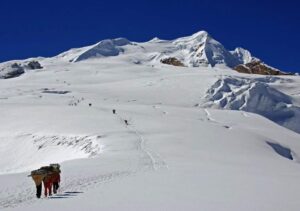Island Peak, also known as Imja Tse by locals, is a magnificent mountain nestled among the giants of the Himalayas. Located in the Chukkung Valley, this peak lives up to its name, resembling an island overshadowed by the massive Lhotse, Nuptse, Shartse, in the north and Baruntse to the south. Reaching the peak provides breathtaking vistas, made much more memorable by the exhilarating ascent up a narrow, exposed slope. As you travel through the Khumbu region, you’ll be treated to stunning vistas from settlements like Namche, Khumjung, Tengoboche, Pandboche, and Dingboche. The valley is dominated by Island Peak, a spectacular pyramid of ice and rock that rises high. This appropriate moniker was given by explorer Eric Shipton, who compared the peak to an island amid a sea of glaciers.
For climbers seeking a technical challenge on a Himalayan peak above 6,000 meters, Island Peak could be the perfect choice. This iconic mountain was even used by Edmund Hillary and Tenzing Norgay as a training ground for their historic Everest summit in 1953. The route they established is still the one used today. Island Peak remains a popular training climb for aspiring Everest summiteers because it hones essential skills like crossing crevasses with ladders and using jumars on fixed lines – techniques crucial for tackling the world’s tallest mountain.
The Island Peak expedition usually lasts roughly 17 days, including 14 days spent walking and climbing in the highlands. This 17-day itinerary includes your time in Kathmandu, and it’s usually a good idea to plan for some extra days in case of flight delays. Also, you can cover Everest Base Camp in these 17 days period; if you do not wish to include Everest Base Camp, you can do it in 14 days, including your stay in Kathmandu.
The walk gradually ascends through the Khumbu Valley, allowing your body to adjust to the high altitude. This approach is essential for a safe and enjoyable climb. You’ll also have the opportunity to climb Chukhung Ri at 5,550 meters for further acclimatization and breathtaking views of Lhotse’s south face. There are also potential add-ons to consider, such as tackling the Kongma La pass with its stunning views of the Khumbu Glacier, Lhotse, Makalu or climbing Pokalde mountain at 5, 806 meters for an added challenge.
The first section of the Island Peak ascent follows the well-known Everest Base Camp trekking path. This indicates you’ll be following a familiar path, albeit it may be bumpy and uneven at times. You will walk the same trail through Namche, Khumjung, Tengboche, Dingboche, Lobuche, Gorakhshep, and Kala Patthar; however, the trail after Chukhung is different. The hike to Island Peak base camp is basic; after base camp, you will face a stretch of hard stones until you reach the crampons point. After crampon point, it’s almost all glacier climbing with crevasses to cross.

